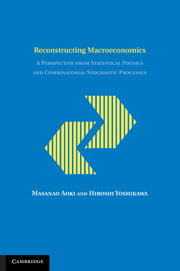 Reconstructing Macroeconomics
Reconstructing Macroeconomics Book contents
- Frontmatter
- Contents
- Preface by Masanao Aoki
- Preface by Hiroshi Yoshikawa
- 1 Introduction: A New Approach to Macroeconomics
- 2 The Methods: Jump Markov Process and Random Partitions
- 3 Equilibrium as Distribution: The Role of Demand in Macroeconomics
- 4 Uncertainty Trap: Policy Ineffectiveness and Long Stagnation of the Macroeconomy
- 5 Slow Dynamics of Macro System: No Mystery of Inflexible Prices
- 6 Business Cycles: An Endogenous Stochastic Approach
- 7 Labor Market: A New Look at the Natural Unemployment and Okun's Law
- 8 Demand Saturation-Creation and Economic Growth
- 9 The Types of Investors and Volatility in Financial Markets: Analyzing Clusters of Heterogeneous Agents
- 10 Stock Prices and the Real Economy: Power-Law versus Exponential Distributions
- References
- Author Index
- Subject Index
- Other books in the series (continued from page iii)
6 - Business Cycles: An Endogenous Stochastic Approach
Published online by Cambridge University Press: 08 August 2009
- Frontmatter
- Contents
- Preface by Masanao Aoki
- Preface by Hiroshi Yoshikawa
- 1 Introduction: A New Approach to Macroeconomics
- 2 The Methods: Jump Markov Process and Random Partitions
- 3 Equilibrium as Distribution: The Role of Demand in Macroeconomics
- 4 Uncertainty Trap: Policy Ineffectiveness and Long Stagnation of the Macroeconomy
- 5 Slow Dynamics of Macro System: No Mystery of Inflexible Prices
- 6 Business Cycles: An Endogenous Stochastic Approach
- 7 Labor Market: A New Look at the Natural Unemployment and Okun's Law
- 8 Demand Saturation-Creation and Economic Growth
- 9 The Types of Investors and Volatility in Financial Markets: Analyzing Clusters of Heterogeneous Agents
- 10 Stock Prices and the Real Economy: Power-Law versus Exponential Distributions
- References
- Author Index
- Subject Index
- Other books in the series (continued from page iii)
Summary
Introduction
Business cycles, or fluctuations of aggregate economic activities, have long attracted economists' attention. A glance at Haberler (1964) reveals that all kinds of theories had already been advanced by the end of the 1950s.
Some theories consider monetary factors, such as changes in money supply, the fundamental factor causing business cycles whereas others consider real factors, such as technical progress, fundamental. Some theories emphasize the role played by exogenous shocks. The famous theory of Jevons (1884), for example, singled out sun spots as the ultimate factor, and traced the chain of causation from sun spots to weather conditions, weather conditions to harvests, and finally from harvests to general business conditions. In contrast, other theorists purged exogenous factors, and constructed models in which endogenous cycles are generated. Goodwin's (1951) model of the nonlinear accelerator is a primary example of such models, Kaldor (1940) is another. More recently, Grandmont (1985) offers another example in which persistent deterministic cycles appear in a purely endogenous fashion without any exogenous shocks. Endogenous cycles produced in these models all rest on the particular nonlinearity of behavior of the representative agent.
Earlier, following the lead of Frisch (1933), Samuelson (1939) demonstrated that the second-order ordinary linear difference equation based on the multiplier and accelerator could generate cycles. Introducing the “ceiling” and the “floor” into such a model, Hicks (1950) ingeniously got around “explosions,” and showed that the model could account for a dazzling variety of cycles.
- Type
- Chapter
- Information
- Reconstructing MacroeconomicsA Perspective from Statistical Physics and Combinatorial Stochastic Processes, pp. 148 - 189Publisher: Cambridge University PressPrint publication year: 2006


